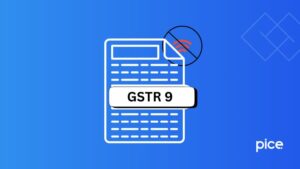What is the Export of Services Under GST?
- 8 Aug 24
- 14 mins

What is the Export of Services Under GST?
Key Takeaways
- GST in India makes exports zero-rated, simplifying the export sector.
- Exporters can choose from LUT, bond, or GST payments with refunds.
- Zero-rated GST enhances global market competitiveness for Indian exports.
- Strategic GST options help exporters optimize cash flow through input tax refunds.
- Leveraging GST benefits is key for exporters to grow globally and comply with regulations.
The article explains how India's Goods and Services Tax (GST) affects the export of services. It talks about the zero-rated supply method, the refund procedure, and the steps and paperwork needed to export goods and services under the GST system.
Export of Goods and Services
Export of goods involves sending physical products from India to other countries, while export of services occurs when service providers in India deliver services to clients outside the country. This plays a important role in foreign market and economic cooperation.
Exports under GST
Exports under GST are considered 'inter-state supplies' and are subject to GST. However, they are treated as zero-rated supplies, which means exporters can export goods and services without GST or claim a refund for the tax paid on inputs used in the production of these exports.

The GST rate varies depending on the nature of goods and services, ranging from exempt to a higher rate for luxury and demerit goods.
To facilitate business operations and promote growth in the economy, the Indian government introduced the Goods and Services Tax (GST) in an effort to unite the market, end the so-called flow effect, and raise compliance levels.
Exports Treated Under GST
The Goods and Services Tax (GST) framework implemented by Indian government provides a flexible approach to facilitate exports, aiming to enhance the competitiveness of Indian goods and services in the global market.
This dual strategy allows exporters to select the most appropriate operations based on cash flow, administrative ease, and business model. Here's a thorough look at the two options:
Exports without Payment of GST
Under this option, exporters are allowed to send goods or provide services outside India without having to pay GST at the time of export. This is facilitated through two main instruments:
Letter of Undertaking (LUT): A LUT is a declaration that allows exporters to export goods or services without the payment of GST. It is available to all exporters who are expected to fulfill certain criteria, primarily based on their past compliance and export performance. The LUT must be furnished to the GST authorities, and once accepted, it is valid for a financial year.
Bond: In cases where an exporter cannot furnish a LUT, they may opt to submit a bond. The bond is accompanied by a bank guarantee, covering the GST amount in which exports are involved.
It functions as a security mechanism, guaranteeing that the government's interests are protected in non-compliance events
Export with Payment of GST and Claim a Refund
Alternatively, exporters have the option to pay GST at the time of export and then claim a refund for the same. This method involves two types of refunds:
Refund of IGST Paid on Exports: Exporters who choose to pay Integrated Goods and Services Tax (IGST) on their exported goods can claim a refund of the IGST paid. Once the customs department has received and processed the shipping bill and export documentation, linking the GST network for verification, the refund process begins.
Refund of Input Tax Credit (ITC): For exporters who export under the LUT/bond without paying IGST, they can claim a refund of the input tax credit on inputs and input services used in the production of exported goods and services. This ensures that the tax paid on inputs is not a cost to the exporter, thereby reducing the overall cost of exports.
Choosing the Right Option

The choice between exporting without payment of GST and exporting with payment of GST and claiming a refund depends on various factors & products, including the exporter's cash flow situation, administrative capabilities, and preference for simplicity versus cash liquidity.
Exporters looking to optimize their cash flow might prefer exporting under LUT or bond, while those who can manage the initial cash outflow might choose to pay GST and claim the refund at the time to benefit from the streamlined refund process.
- Zero-rated supply: Exports are treated as zero-rated, meaning no GST is charged on exports, and exporters can claim a refund for input tax credits.
- Refund mechanism: A robust refund mechanism is in place for exporters to claim refunds on the GST paid on inputs.
Simplified procedures: The GST regime simplifies procedures for exporters, including the filing of GST returns and refund claims. - Reverse charge: The significant feature of GST is the reverse charge mechanism, where the recipient of goods or services is liable to pay GST instead of the supplier.
Place of Supply for Export of Goods
For GST purposes, the place of supply of service for the export of goods is the location outside India to which the goods are shipped. This classification ensures that most of all exports are treated as zero-rated supplies.
Export options available to the exporters
Exporters have several options under the GST regime:
- Export under Letter of Undertaking (LUT):
Exporters can ship their goods or services without paying GST by furnishing a Letter of Undertaking (LUT). This option is available to all exporters who satisfy certain conditions, allowing them to export without the immediate financial burden of GST.
The LUT essentially assures the authorities that the exporter will comply with all the requirements of the GST laws.
- Export under bond:
Similar to the LUT, exporters have the option to export goods without paying GST by furnishing a bond. This bond, unlike the LUT, may also require some security or surety.
The bond option is especially useful for exporters who don't meet the requirements for an LUT. It serves as a guarantee that the exporter will fulfill all the GST obligations.
- Payment of GST and claim refund:
Exporters can choose to pay GST at the time of export and then claim a refund later through the online GST portal. This option ensures that the government collects the applicable taxes upfront, with the exporter entitled to a refund once the goods are exported.
The government gains a cash flow benefit from this strategy in addition to the assurance that exporters won't ultimately be responsible for the tax, which they may refund.
These GST choices show the Indian government's efforts to assist exporters by lowering the cost of taxes on exported goods and services.
The regime's goal in giving tools like as LUT, bonds, and refunds is to expedite the export process, encourage compliance, and make Indian exports more competitive on the international market.
Documents & Processes for exporters under GST
Exporters must comply with specific documentation and procedural requirements, including:

Shipping bill
Mandatory for exporting goods. The shipping bill is an important document necessary for the shipment of products from India. It serves as the primary customs document that exporters must submit at the time of shipment.
- The shipping bill provides specific information about the shipped products, such as their description, quantity, value, and destination.
It also offers information about the exporter and the shipping route. - The shipping bill is required for customs clearance and to put cargo onto the shipping vessel. For goods transported by air, the equivalent document is known as the airway bill.
Export invoice
The export invoice is a critical document that accompanies every export shipment. It details the transaction between the exporter and the overseas buyer, listing the goods or services provided, their value in foreign currency, and the terms of sale (Incoterms).
The export invoice must also include the GSTIN of the exporter, the tax invoice number, and the date of issue. It serves as a proof of sale and is essential for the calculation of the GST refund on input taxes.
Filing of GST Returns
Exporters are required to file regular GST returns on the GST Portal, which include details of their export transactions. The key returns are:
- Form GSTR-1: This return contains details of outward supplies, including exports. Exporters must report each export transaction at a time under separate tables within form GSTR-1 on the GST portal, providing details such as the invoice number, date of issue, value, GST paid on inputs, and the shipping bill number. The return form GSTR-1 is filed monthly or quarterly, depending on the turnover of the business.
- Form GSTR-3B: The summary return form GSTR-3B is filed monthly, summarizing the total value of domestic and export sales and purchases. Exporters must report the total value of exports and the input tax credit availed, which is crucial for claiming refunds.
- Form GSTR-6: For exporters who are also input service distributors, filing GSTR-6 is necessary to distribute the input tax credit to their units.
Refund Claims
To claim a refund of the GST paid on inputs used in the production of exported goods or services, exporters must follow a specific procedure at the time of filing their return on the portal:
- Relevant filing of returns: Ensure that GSTR-1 and GSTR-3B are filed accurately and on time, reporting all export transactions and input tax credits.
- Application for Refund: Submit an application for refund in Form GST RFD-01 on the GST portal. The supporting documentation for this application should include export invoices and export documentation.
- Bank Realization Certificate (BRC): For goods exports, submit the BRC as proof of receipt of export proceeds in foreign currency. This document is crucial for processing the refund.
How will GST on exports be levied?
Exports are zero-rated, and GST is not levied on exports. Exporters can claim a refund for the input tax credit on inputs used in the production of exported goods and services.

Deemed Exports
Certain transactions are treated as deemed exports, where goods supplied do not leave India but are considered exports under GST. Suppliers of deemed exports can claim refunds on the GST paid.
Documents Required for Export Claiming Refund
For importers, getting a GST return is very important because it has a direct effect on their cash flow and how well their business runs. India's items and Services Tax (GST) system lets sellers get their money back if they paid GST on inputs that were used to make items or services that they then sold.
So that traders can get their money back, this process has been quickened up. This makes Indian goods and services more competitive on the world market. Here are the key documents required for claiming a GST refund on exports:
Export Invoice
The export invoice is a primary document that details the transaction between the exporter and the foreign buyer. It includes information such as the description of goods or services exported, the quantity, the value in foreign currency, and, importantly, the GST paid on inputs.
This document serves as proof that the goods or services were indeed intended for export and that GST was incurred on the inputs used.
Proof of Export
Proof of export is essential to establish that the goods have left the country or that the services have been rendered to a client outside India. This can be provided in the form of:
- Shipping Bills: At the time of export, the shipping bill is the main document that the customs authorities process. It lists the things being exported, how much they are worth, and the place where they are going.
- Airway Bills: Used for goods transported by air, airway bills are comparable to shipping bills. They both show proof of sale, which is the same thing.
These documents are crucial, as they are used by the GST authorities to verify that the goods have indeed been exported and are eligible for a refund of the GST paid on inputs.
Bank Realization Certificate (BRC)
As evidence that the exporter has received payment in foreign currency from the overseas buyer, banks issue the Bank Realization Certificate (BRC). This document is very important because it shows that the foreign gains were received, which is a must in order to get the GST return.
The BRC helps make sure that the exports are real and that the foreign exchange has been sent back to India in line with the rules for managing foreign exchange in the country.
Additional Documents
Depending on the specific circumstances of the export transaction and the requirements of the GST authorities, exporters may also need to submit additional documents, such as:
- Letter of Undertaking (LUT): If the exporter has exported goods or services under an LUT without payment of GST.
- FIRC (Foreign Inward Remittance Certificate): Similar to the BRC, the FIRC is another proof of receipt of payment in foreign currency, which may be required in some cases.
Conclusion
India's goods and services are now more competitive outside because of the country's GST policy, which has streamlined export taxes. Through comprehension and application of the characteristics of the GST scheme for exports, exporters can secure compliance with tax legislation while augmenting their global market position.
Leverage this guide and the PICE application to streamline your GST payments efficiently.
FAQ s
What qualifies as an export of services under GST?
The supplier is located in India.
The recipient is located outside of India.
The place of supply of the service is outside India.
Where the Reserve Bank of India permits, the service provider receives payment in convertible foreign currency or Indian rupees.
The supplier and recipient are not merely establishments of a distinct person.
Are exported goods and services GST free?
Is GST refunded on export?
Who can claim a refund in GST?
What is the GST rate for exports?
What goods and services are GST free?
Can exporters of services opt for the composition scheme under GST?
This scheme is not available for service providers who are involved in exports.
The primary reason is that the scheme is designed for small businesses with limited interstate supplies, and exporting services inherently involves cross-border transactions.
Exporters must adhere to the standard GST rules, including registration, tax payments, and refunds.




















